
| 
|

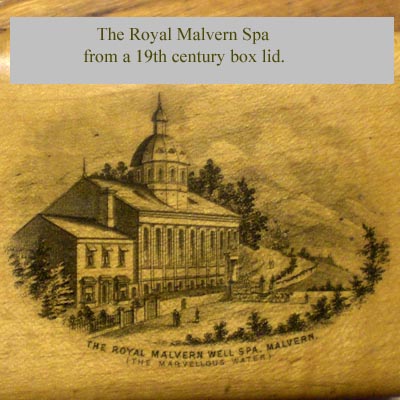
Royal Malvern Spa (St Thomas's Well)
NGR 76771 44172
Site Number: C44
By Bruce Osborne and Cora Weaver (C) 2012
Area 4. West Malvern Springs and Wells
Malvern Hills, England
Description: The site of a former temple of health. The outflow, from an earthenware pipe, can now be seen alongside a footpath across the road from the site of the old Royal Spa.
William Hawkes Ryland began work in Birmingham in 1852 as a gold-plate maker eventually partnering the Birmingham Empire Wire Mills Co. In 1882 he retired from business a very rich man, with the time, money and motivation to carry out his enormous scheme to build a pleasure complex for the enjoyment of the local inhabitants and visitors. At great personal expense William Hawkes Ryland built the Royal Malvern Well Spa Hall and Pleasure Grounds, which opened in 1883. Inside the Spa Hall, the statue of an angel dispensed Royal Spa spring water from a lily; outside there was a further fountain in a rustic grotto. Within two years the grand attraction was in financial difficulties. By 1890 it had closed and Ryland was bankrupt.
This is the site of St Thomas's Well, one of only three springs or wells that appear on the 1633 enclosure map of Malvern Chase. The location is confirmed by the 1840 tithe map for Mathon, which also shows Mary Woodyatt living at St Thomas's spring. Because the spring was formerly in the parish of Mathon, Herefordshire, and the water was once reputed to be the purest in The Malverns,[1] it was probably named in honour of St Thomas of Hereford (Thomas Cantelupe 1218-82, Bishop of Hereford 1275-82). Like his uncle, a bishop of Worcester, Thomas was a saintly man. He wore a hair shirt and spent much time in his see, and was zealous in his campaing to confirm children. He also regained rights in his diocese that had been surreptitiously sequestered. It is said that many years ago on St Thomas's Day, 2nd October, the poor of Colwall received payments made on the Colwall stone.
Apart from Ryland's testimony, there is no other history of this being a healing well, though an advertisement promoting the principal carriage drives around Malvern in 1887 claims, 'The Royal Malvern Well Spa has a copious medicinal spring, notorious with St Ann's and Holy Well.'[2] This reputation undoubtedly attracted visitors to West Malvern in the nineteenth century. The copious supplies of pure water, pure air and remarkable scenery were insufficient attractions according to the entrepreneurial Lucy Dalton of Mathon, who in the early 1830s began to haul heavy loads of ginger beer and cakes up to West Malvern to sell to the few visitors. It was a difficult task, since at that time there was no road built from Mathon, but perhaps it explains Lucy's longevity: she died on the 31 December 1884, aged 95!
The Royal Malvern Well Spa Hall and Pleasure Grounds - Originally William Ryland was approached by wealthy entrepreneurs who asked him to build a well-room where the public could take the waters. The idea had great appeal but instead he decided to build an enormous pleasure palace for the enjoyment of the local inhabitants and visitors, to ensure that they could take the life-giving waters freely. Ryland had retired retired from business in 1882, a very rich man. He had the time, money and motivation to carry out his enormous scheme.
The Royal Malvern Spa was built on the site of St Thomas's Well and the cottages that Ryland had bought to ensure his cure. Work started on the grand scheme in 1881 but several unfortunate incidents occurred which convinced the natives that the place was bewitched and the buildings would not stand. Unimpressed, Ryland worked on, hiring local men to do the work and never expecting more than a shilling's worth of work for a shilling.
On the five acres where the dilapidated cottages once stood were built a huge complex of Pump Room, Art Gallery, Pleasure Gardens and Concert Hall, designed by a London architect. The Spa Hall was built in a Corinthian style using Bath stone and Malvern Hills granite. It measured 150 ft. x 60 ft. and was 76 ft. from the floor to the top of the dome. There was seating for over 2000 in the central hall and art gallery, central heating, and extensive views were to be had from the elevated pleasure gardens.[3]
Unsurprisingly, '...the central attraction is the statue fountain, in a recess on the east side. It is approached by stone steps, is screened off by ornamental woodwork, and is fixed in the midst of an effective grouping of rockery, virgin cork etc., while just above is a pretty fairy cataract adown which water can be made to tumble at will independently of the drinking stream. The statue is in composite marble, designed by Messrs.Rogerson (Liverpool) and modelled by an Italian artist; it represents an angel dispensing the elixir vitae from a water lily in the left hand, while on the right arm rests a scroll thus inscribed - `God's water. Drink and thirst not. Pure water is life.'...the water from this spring is proved to be very remedial in gout, rheumatism, liver and renal complaints, and general debility.'[4] Either side of the main fountain stood two Indian Gods, said to be over 2000 years old. Outside there was a further fountain in a rustic grotto.[6]
The well poured forth its elixir at a rate of 70,000 gallons a day, far in excess of Holy Well and St Ann's Well. According to the visitor guide the location and the waters were claimed to give great longevity, as proved by some nineteenth century local residents Elizabeth Saunders, who lived to to be 104; Thomas Jenkins 107 and a Mr. King 102 years.[5]
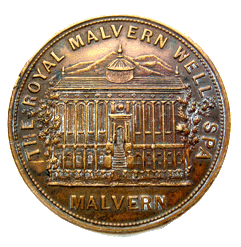
The Royal Malvern Spa Hall and Pleasure Gardens were officially opened on 7 May 1883. Unfortunately Earl Beauchamp could not attend the inauguration, when he was to unveil the Statue Fountain, so at 11 am Ryland himself performed the task. 'He trusted it would be a monument which many thousands of persons would speak of as the scene of the restoration of their health....' Other celebrations at the opening included a spectacular fireworks display by C T Brock and Co of Crystal Palace, and music from the town's Rhine Band and Malvern Recreation Band. The Worcester Philharmonic Society provided a 50 strong chorus and the concert program ended with a rendition of 'Rule Britannia'. About 2000 visitors attended the opening.[6]
Opening daily except Sundays, day-trippers could get in on production of their train ticket and 3d; all others were charged sixpence (6d) for admission. How afforable was this? Using the Average Earnings index 6d then would be in excess of 13 pounds today. The complex became a huge success, attracting thousands of visitors with a multiplicity of events, including an All-Night Ball. The very idea stimulated an apoplectic letter from John Nott, one of Great Malvern's staid and upright citizens. He declared that youngsters should not stay out until 4 o'clock in the morning nor be subjected to the availability of alcohol, which they would doubtless misuse, adding that anyway '...more than one person suggested that a probable case for the Lunacy Commissioners would be made in consequence of such a building existing in a place so remote from public resort.'[7]
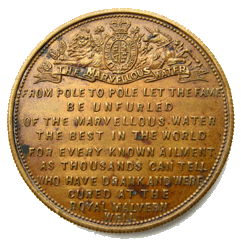
Having enviously seen the rampant success of Ryland's venture, the Great Malvern Assembly Rooms and Pleasure Gardens opened on 1 July 1885, as competition with Ryland's Spa Hall and gardens. The latter ceased advertising and declined rapidly, but Ryland did not give up easily. In October 1887 he applied to the County Brewster Sessions at Hereford to convert the Assembly Room into the Royal Malvern Spa Hotel. The site and existing buildings had already cost him 10,000 pounds but he was prepared to pay a further 5,000 pounds 'and convert it into an hotel, which would afford much-needed accommodation as a health resort.'[8] The application was granted for a first class, 45 bedroom hotel. In December Ryland asked W H Bentley of Worcester to auction certain fixtures of the Royal Malvern Spa Hall, and in anticipation of the proceeds borrowed 40 pounds from the auctioneer. Bentley was then alerted to the fact that the terms of Ryland's mortgage forbade such an auction so the goods were removed to Birmingham where they realised 217 pounds. Ryland refused to pay Bentley for his labours, despite having deliberately misled him regarding the propriety of auctioning the goods. In court Ryland was ordered to pay costs and his debt.[9]
Ryland hoped that his development would popularise the Herefordshire side of the Malvern Hills but his project was a disaster. In 1889 he went into partnership with Henry Watkins in the Birmingham Empire Wire Mills Company, but the factory machinery was defective, the business failed, and Ryland and Watkins could not pay their suppliers. 'This undertaking had proved disastrous, and the bankrupt had not been able to sell it.' [10] The 'bankrupt' was the formerly hugely wealthy William Hawkes Ryland who in October 1890 was declared bankrupt, with liabilities of 14,079 pounds against assets of just 2,436 pounds. He was also unable to sell The Royal Malvern Spa. After just twelve years the development closed and became known as Ryland's Folly. In the 1920s the building became unsafe and was demolished.
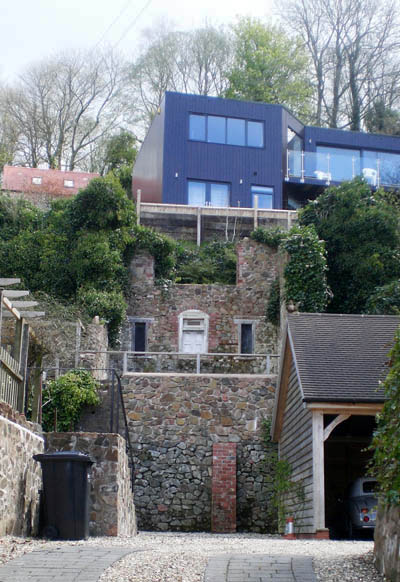
Today this once grand building is no more. The site has been developed by the adjacent house owner and a wooden building erected. High on the bank against the hills, exploration in 2012 has revealed the remains of Rylands Spa Fountain plinth, once at first floor level in the grand spa hall. St Thomas's Spring flows to waste.[14] The Royal Spa Lodge, Spa Cottage and several ruinous gate pillars are all that survive. But The Royal Malvern Spa will remain famous, for that was where, at a concert on 23 July 1883, Swedish Nightingale Jenny Lind gave her last public performance, to raise money for the Railway Servants' Benevolent Fund.

1. Royal Malvern Spa.
2. Cora inspects the outfall west of the road.
3. The Royal Well Spa Hall in 1891 with its characteristic dome just four years before it closed. Historical, Descriptive Malvern c.1891. (courtesy Ken Davies)
4. Royal Spa Lodge. This building is located on the same spot as the north-west corner of the original Royal Spa. It also appears to replicate the front design of the original spa building.
5. Royal Well House.
6. The remains of Rylands Spa Fountain discovered in 2012. (see Friends Newsletter 44)
7. Stonework from the spa building survives in the adjacent gardens.
[1] Smith, B. 1964, A History of Malvern, p211.
[2] Malvern Advertiser, 13 August 1887.
[3] Malvern Gazette, May 5 1983.
[4] Malvern Advertiser, 21 July 1883.
[5] Guide to the Royal Malvern Spa Hall, Art Gallery and Pleasure Grounds, c.1883.
[6] Malvern Gazette, 5 May 1983.
[7] Malvern Advertiser, 21 July 1883.
[8] Malvern Advertiser, 7 July 1888.
[9] Malvern Advertiser, 7 July 1888.
[10] Birmingham Daily Post 3 October 1890.
[11] The Imperial Hotel, Handbook to Malvern, Malvern (1875) p153.
[12] Malvern Gazette 6 Oct. 2000.
[13] Weaver C. Osborne B. Aquae Malvernensis 1994, p224.
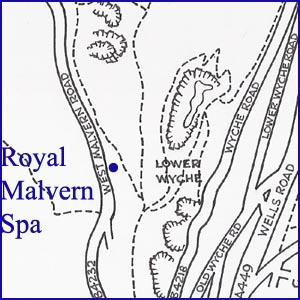
Website: Click Here
SUPPLEMENTARY INFORMATION

Celebrated Springs of
THE MALVERN HILLS
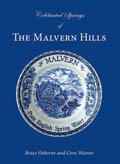 A definitive work that is the culmination of 20 years researching the springs and wells of the Malvern Hills, published by Phillimore. This is the ideal explorers guide enabling the reader to discover the location and often the astounding and long forgotten history of over 130 celebrated springs and wells sites around the Malvern Hills. The book is hard back with dust cover, large quarto size with lavish illustrations and extended text. Celebrated Springs contains about 200 illustrations and well researched text over a similar number of pages, together with seven area maps to guide the explorer to the locations around the Malvern Hills. It also includes details on the long history of bottling water in the Malvern Hills.
A definitive work that is the culmination of 20 years researching the springs and wells of the Malvern Hills, published by Phillimore. This is the ideal explorers guide enabling the reader to discover the location and often the astounding and long forgotten history of over 130 celebrated springs and wells sites around the Malvern Hills. The book is hard back with dust cover, large quarto size with lavish illustrations and extended text. Celebrated Springs contains about 200 illustrations and well researched text over a similar number of pages, together with seven area maps to guide the explorer to the locations around the Malvern Hills. It also includes details on the long history of bottling water in the Malvern Hills.
Written by Bruce Osborne and Cora Weaver, this book is available on-line for £15.00 (delivered UK) - click Malvern Bookshop on the green panel top left. Alternatively send a cheque payable to Cora Weaver with your name and address to 4 Hall Green, Malvern, Worcs. WR14 3QX.
1) TOPOGRAPHICAL LOCATION:
Malvern Hills - arguably Britain's original National Park
2) LANDSCAPE:
Rural Village3) INFORMATION CATEGORY:
A Spring, Spout, Fountain or Holy Well Site4) MALVERN SPRING OR WELL SITE DETAILS:
Site with Malvern Water2 SPLASHES - Not Much To See

5) GENERAL VISITOR INFORMATION:
Access By RoadAccess On Foot
On Private Property
Not Open To Public






